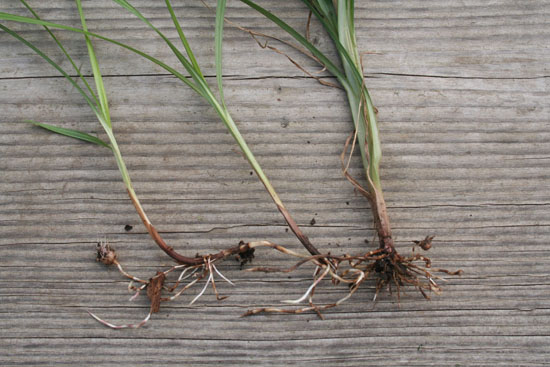Issue 5, May 21, 2012
Yellow Nutsedge
Newly emerged yellow nutsedge (Cyperus esculentus) has been spotted around central Illinois recently. Also known as yellow nutgrass, yellow nutsedge is a warm-season perennial member of the Cyperaceae (sedge) family that reproduces by seeds and from tubers (nutlets). Though the sedge family contains 98 to 146 genera and over 5,300 species, the most common weedy sedge found in lawns and landscapes across the state is yellow nutsedge. It also holds the distinction of being one of the world's worst weeds. Once cultivated in ancient Egypt for its tasty and oil-rich tubers, it has now spread to all continents1. Illinois is home to several different species of sedges, many of which are featured at www.illinoiswildflowers.info/. This website and some others say yellow nutsedge is a native plant. I can't say who is correct but I can say that identification can be quite difficult. And really, when it has invaded your lawn or garden, do you care what country it originated from? The main focus then is on identification and control.
Life cycle and appearance. Individual yellow nutsedge plants have upright, grasslike leaves that emerge from a fibrous root system, and scaly, white or light-colored rhizomes. The base of the plant is distinctly triangular in shape. Grasses have round or oval shaped stems. One yellow nutsedge plant may produce hundreds or even several thousand tubers in a season. The tubers develop rapidly six to eight weeks after the plants emerge, usually during late July and August, and can persist for many years in the soil. Forming at the ends of rhizomes (not in chains as occurs in other sedges such as purple nutsedge), the nutlets can reach up to 4/5 inch in length. Most tubers can be found in the top 6 inches of the soil and a chilling period is required to break dormancy. New plants emerge from tubers from late May to mid-July. Leaves emerge from the plant's base, are three-ranked, grasslike, and light yellow-green, 1/8 to 1/2 inch wide, up to three feet long, and have parallel veins with a prominent fold in the middle. The upper surface of the leaf is shiny or waxy, and the lower surface is dull. Nutsedge leaves grow rapidly during summer; they often grow above the canopy of cool-season turf. Nutsedge inflorescences (flowers) are flat topped and multiple branched with long, leaflike bracts beneath. The inflorescences resemble burrs and occur at the end of a stout, triangular (in cross-section), yellow-green stem. Each branch of the inflorescence is composed of multiple yellow-to-golden brown spikelets, each up to 1-1/4 inches long. The inflorescences appear July to September during 12-to-14-hour days.

Yellow nutsedge.
Ecology. Yellow nutsedge is often an indicator of poor drainage. It grows on all soil types, especially wet or moist sites or sites receiving heavy irrigation. It usually appears on soils with a pH of 5 to 7. Yellow nutsedge does not tolerate shade and will tolerate dry sites once it is established.
Control. Due to the tubers' reproductive capacity, controlling yellow nutsedge is very difficult after the tubers have formed. To control without chemicals, maintain turf density and health through proper culture; mechanically remove or pull nutsedge plants soon after germination, and increase drainage in moist or wet areas. Keep in mind that tillage will spread this plant. Mow low (to less than one inch on turf species tolerant of that practice) and frequently to reduce growth from the plant base. Purchase nutsedge-free sod and soil. Fertilize turf in autumn after nutsedge growth has slowed. Chemical controls for yellow nutsedge include fumigation and herbicides. Several postemergence herbicides can be used, but total control can be difficult and such products may require multiple applications. Basagran T/O (bentazon) is a contact herbicide and good coverage of application is essential. Systemic options include SedgeHammer (halosulfuron), Certainty (sulfosulfuron), Tenacity (mesotrione), and Dismiss (sulfentrazone). Labels for these products provide information about adjuvants and additional recommendations for controlling this pesky plant. Turf managers have reported that applications of Roundup (glyphosate) have resulted in poor yellow nutsedge control. Be sure to read and follow herbicide labels very carefully.
Literature Cited:
1. Defelice, M.S. 2002. Yellow Nutsedge Cyperus esculentus L.–Snack Food of the Gods. Weed Technol. 16:901-907.
(Michelle Wiesbrook, adapted from an HYG article by Bruce Spangenberg, Tom Voigt, and Bruce Branham.)
Author:
Michelle Wiesbrook